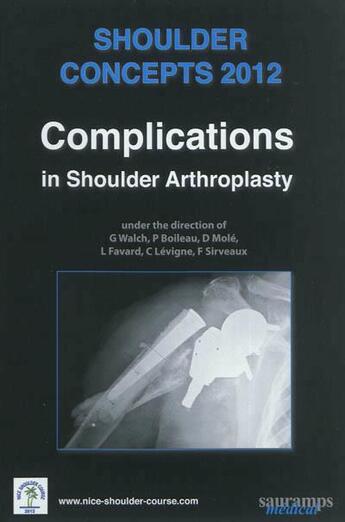Merci à toutes et à tous pour cette aventure collective
Passionné(e) de lecture ? Inscrivez-vous
gratuitement ou connectez-vous pour rejoindre la
communauté et bénéficier de toutes les fonctionnalités du site !

What Are the Complications after Shoulder Arthroplasty? Can We Avoid Them?
A concern regarding shoulder arthroplasty (SA) is the possible Intraoperative and postoperative complications that can jeopardize and/or compromize the functional results. Intraoperative complications during SA must be anticipated. Postoperative course after SA can be complicated by neurologic problems, periprosthetic fractures, rotator cuff tears, instability, stiffness, implant loosening, osteolysis, infection, and even death. In addition, there is a substantial rate of associated complications. Many questions remaine unanswered: What are exactly the complication rates after SA? What are the risk factors?
The type and rate of complications depends highly on the diagnosis. For instance, we know now that the fracture sequelae patients had a higher rate of complications when compared with those operated for primary osteoarthritis. We also know that the rate of infection is higher in revisions than in the primary cases. In addition, there is a possibly higher complication rate with certain type of prosthesis: for instance, the rate of complications with the reverse shoulder arthroplasty (RSA) is higher than the ones observed with an anatomical, conventional unconstrained shoulder arthroplasty (ASA). The type of prosthesis fixation (cemented, press-fit or uncemented implants) may also influence the nature and rates of complications.
The experience of the shoulder surgeon is, of course, one of the main factors that influence the intra and postoperative complication rates after SA. This is the reason why we have asked a group of shoulder experts to share their knowledge regarding their complications during and after SA. These experts were invited to participate to the Nice Shoulder Course - Current Concepts in Nice on June 7, 8, 9 2012. The reports of these experienced shoulder surgeons and analysis of the available literature represent the basis of this book.
The goal of this book is therefore to determine: 1) the nature and rate of the complications after SA; 2) whether diagnosis influences the type and rate of complications (OA, RA, Fracture and Fracture Sequelae); 3) whether the type of prosthesis implanted influences these complications (hemi, total, reverse, stemless prostheses); 4) whether these complications affect functional results and scores after SA; and 5) how it is possible to prevent and avoid them.
The information provided by this book should hopefully allow surgeons to improve their practice in order to prevent some of the complications, when possible, but also to give patients realistic expectations regarding the complication nature and rates after SA.
Il n'y a pas encore de discussion sur ce livre
Soyez le premier à en lancer une !

Merci à toutes et à tous pour cette aventure collective

Lara entame un stage en psychiatrie d’addictologie, en vue d’ouvrir ensuite une structure d’accueil pour jeunes en situation d’addiction au numérique...

Un douloureux passage à l'âge adulte, entre sensibilité et horreur...

Blanche vient de perdre son mari, Pierre, son autre elle-même. Un jour, elle rencontre Jules, un vieil homme amoureux des fleurs...